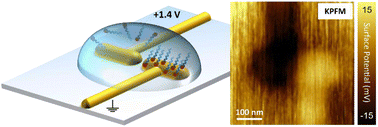Site-selective functionalization of in-plane nanoelectrode-antennas†
Abstract
Stacked organic optoelectronic devices make use of electrode materials with different work functions, leading to efficient large area light emission. In contrast, lateral electrode arrangements offer the possibility to be shaped as resonant optical antennas, radiating light from subwavelength volumes. However, tailoring electronic interface properties of laterally arranged electrodes with nanoscale gaps - to e.g. optimize charge-carrier injection - is rather challenging, yet crucial for further development of highly efficient nanolight sources. Here, we demonstrate site-selective functionalization of laterally arranged micro- and nanoelectrodes by means of different self-assembled monolayers. Upon applying an electric potential across nanoscale gaps, surface-bound molecules are removed selectively from specific electrodes by oxidative desorption. Kelvin-probe force microscopy as well as photoluminescence measurements are employed to verify the success of our approach. Moreover, we obtain asymmetric current–voltage characteristics for metal–organic devices in which just one of the electrodes is coated with 1-octadecanethiol; further demonstrating the potential to tune interface properties of nanoscale objects. Our technique paves the way for laterally arranged optoelectronic devices based on selectively engineered nanoscale interfaces and in principle enables molecular assembly with defined orientation in metallic nano-gaps.



 Please wait while we load your content...
Please wait while we load your content...